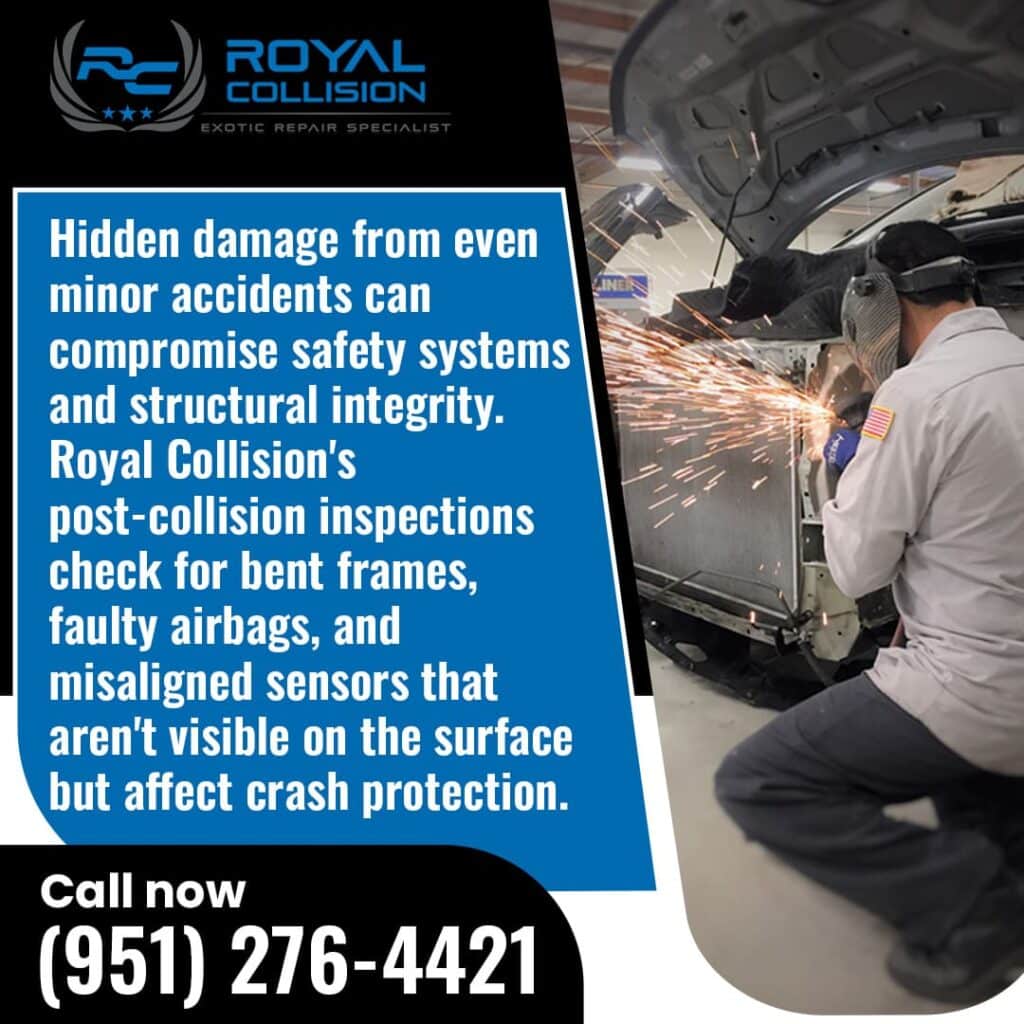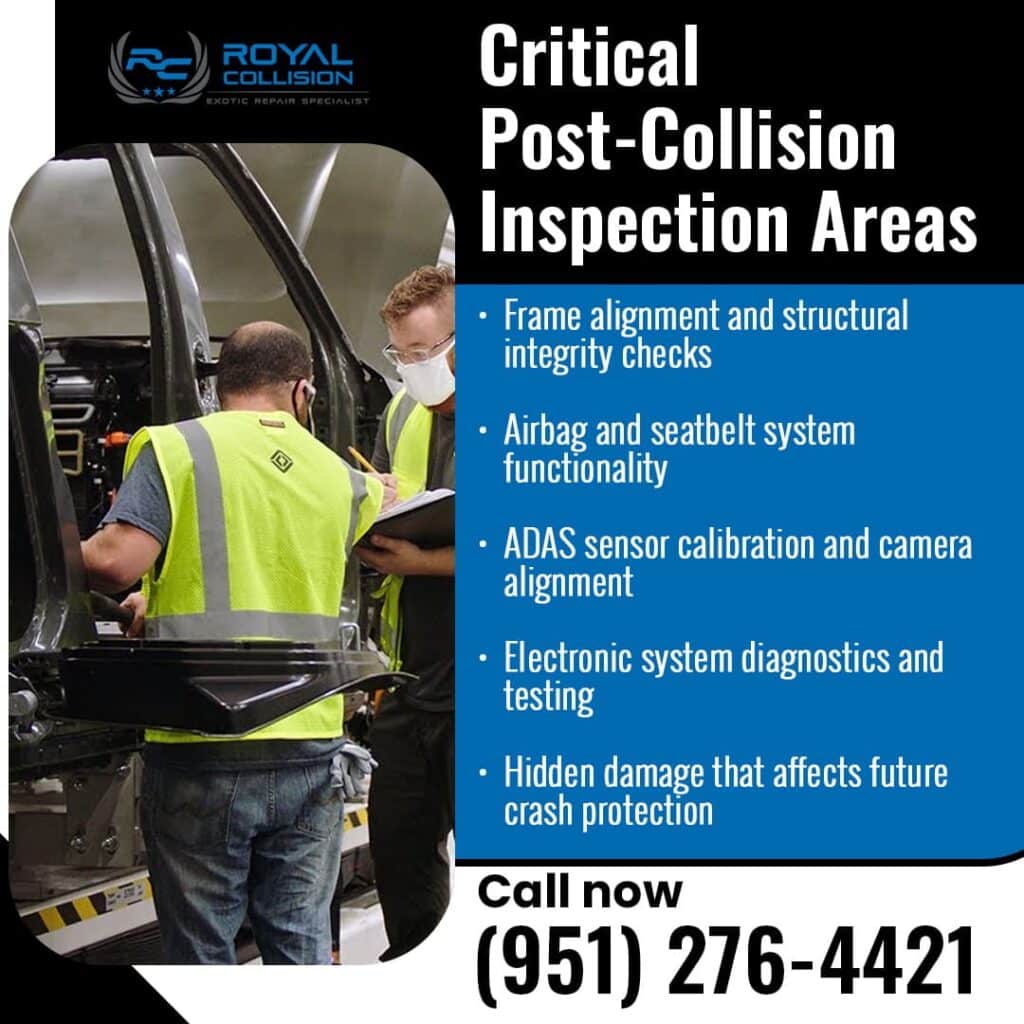Many drivers assume the damage is only what they can see: scratches, dents, or broken lights. But modern vehicles are built with advanced systems, and hidden problems are often more serious than what shows on the surface. A bent frame can weaken crash protection even when the body looks normal. Sensors that control lane assist or blind spot alerts may stop responding.
Airbags may fail in another crash if the system has been damaged. For this reason, drivers should schedule a post-collision inspection as part of a complete collision and repair process. A professional auto body inspection goes beyond appearance. It checks the structure, electronics, and safety systems that protect drivers every day.
At Royal Collision, every repair is completed with OEM parts and manufacturer-approved methods, giving drivers confidence that their vehicle is restored properly.

Why a Post-Collision Inspection Matters
A post-collision inspection verifies that a vehicle is fully safe to drive after an accident. Even minor crashes can cause hidden structural shifts, electrical faults, or calibration issues that are not visible at a glance. Skipping an auto body inspection after a minor car accident can leave airbags, seat belts, or driver-assist systems unable to protect passengers. This is why trusted collision repair shops emphasize detailed inspections for every vehicle.
At Royal Collision, our certified team examines frame strength, airbag readiness, sensor accuracy, and body alignment with precision equipment. Each step is designed to identify damage that could affect how the car responds in another crash. A detailed vehicle safety check also protects long-term value. When repairs meet manufacturer standards, drivers not only stay safer on the road but also maintain confidence when it comes time to sell or trade their vehicle.
What a Post-Collision Inspection Covers
A detailed accident evaluation goes beyond dents or scratches. Certified technicians examine critical systems to uncover hidden damage and confirm that repairs meet manufacturer standards, so that the vehicle is safe and road-ready.
1. Frame and Structural Integrity
The frame is the vehicle’s structural framework. If it is bent, weakened, or misaligned, the car may not provide proper protection in a future accident. Even slight shifts can disrupt wheel alignment, steering response, and overall stability. Cracks or weak points may also worsen with time. Professional frame inspections and repairs restore strength so the vehicle remains safe and reliable. Skilled technicians use precision measuring equipment to detect even the smallest deviations. Correcting these issues maintains the original crash protection built into the vehicle.
2. Airbags and Seat Belt Systems
Airbags and seat belts are central to passenger protection. After a collision, damaged sensors, wiring, or retractors may prevent these systems from working correctly, sometimes without triggering a dashboard light. Detailed inspections include direct testing to confirm proper operation. Any compromised components are replaced so the system functions as intended. This step gives drivers confidence that safety features will respond in a future emergency. It also brings the vehicle back in line with factory safety standards.
3. ADAS Sensors and Calibration
Modern vehicles rely heavily on safety technology such as lane departure warning, blind-spot monitoring, and forward collision warning. Even a minor impact can move sensors or cameras slightly, leading to false alerts or complete system failure. During inspection, technicians perform ADAS recalibration to restore accuracy and confirm that safety features like lane departure warning and forward collision warning work as intended. Proper calibration makes sure that these tools support the driver as designed. It also reduces the risk of unexpected malfunctions on busy roads.
4. Body Panel Alignment and Safety
Body panels affect far more than appearance. Improper alignment can cause water leaks, wind noise, and early rust. Misaligned panels may also interfere with airbag deployment in another crash. A careful inspection evaluates panel fit and consistency across the vehicle. Correcting alignment improves both safety and the car’s factory-quality look. Proper fit also helps maintain the vehicle’s resale value. It prevents further damage by protecting the car from moisture and weather intrusion.
5. Diagnostics for Electronic Safety Systems
Today’s vehicles depend on advanced electronics for critical functions such as traction control, stability systems, and braking assistance. A collision can damage wiring, loosen connections, or disrupt modules, even if the dashboard shows no warning. Thorough diagnostics identify hidden electrical problems so the vehicle operates as designed.
This process confirms the car is road-ready again. Skipping these checks can leave major risks hidden under the surface.
Timeline Considerations for Post-Collision Inspections
Timing is critical when scheduling a post-collision inspection. Certain problems, such as fluid leaks, electrical faults, or wheel misalignment, may not appear until hours or even days after the accident. Waiting too long allows underlying issues to worsen and can turn small concerns into major safety risks. It’s best to schedule an inspection within 48 hours of a crash, even if the damage appears minor. Many auto collision shops recommend quick action so problems do not spread to other systems.
Early detection allows technicians to complete the right auto body repair before issues spread to other systems. Acting quickly also supports insurance claims by providing documented evidence and preventing corrosion or weather exposure from creating new damage.
Insurance Documentation and Claims Support
A post-collision inspection is not only about detecting hidden damage; it also creates vital records that support both safety and the repair process. Professional reports often include photos, measurements, and detailed notes, giving drivers clear proof of a vehicle’s condition after an accident. This type of documentation strengthens insurance claims and supports that safety-related concerns are not overlooked.
Thorough documentation also protects drivers long-term. If questions arise months after a crash, a detailed car accident safety inspection record shows that the damage was properly identified and addressed at the time of repair. By putting safety first, these reports help secure complete repairs and greater confidence on the road.
The Role of Collision Repair in Vehicle Safety
Finding hidden problems is only part of the process. Correcting them through skilled collision repair inspection is just as important. A proper repair brings the car back to its pre-accident condition by restoring both structure and safety systems. At our shop, technicians follow manufacturer-approved methods and use OEM parts. Non-OEM or aftermarket components may look similar, but they often fail to deliver the same crash protection. By using factory parts, the performance of airbags, sensors, and structural integrity is protected.
A professional vehicle safety check confirms that the repairs have been done correctly. From ADAS recalibration to frame alignment, every step matters in bringing the vehicle back to factory safety standards. Without this process, a car may look fixed but still carry serious safety risks.
Protecting Vehicle Value With Post-Collision Inspections
A post-collision inspection is not only about immediate safety; it also supports the long-term condition of your vehicle. Even minor accidents can create hidden issues that reduce both reliability and resale value if left unaddressed. Buyers, dealerships, and even insurers often look for clear repair records, and incomplete or low-quality work can raise concerns.
A professional auto body inspection verifies that the car has been restored to manufacturer standards. By using OEM parts and documenting every repair, technicians confirm that the vehicle’s safety and performance remain intact. A well-documented vehicle safety check also reassures future buyers that the car is dependable after a crash. With expert collision and repair services, drivers gain confidence that their vehicle is restored correctly and ready for the road ahead.
Skipping an inspection can lead to long-term problems such as rust, electrical faults, or weakened frame components. These issues not only compromise safety but can also result in costly repairs later. Scheduling an auto body inspection in Riverside, CA, protects both the driver and the long-term value of the vehicle.

Frequently Asked Questions (FAQs)
1. Can I drive my car before a post-collision inspection?
It is not recommended to drive a vehicle before a post-collision inspection. Hidden issues such as frame damage, faulty airbags, or misaligned sensors may affect how it performs on the road. Driving without an inspection increases the risk of reduced protection in another crash.
2 Will a post-collision inspection find hidden safety issues?
Yes. A post-collision inspection can reveal hidden problems such as frame damage, sensor faults, or airbag issues that may not be visible on the surface. If left unaddressed, these risks can compromise crash protection and reduce the effectiveness of safety systems, making the inspection an important step for vehicle safety.
3. What is the difference between a post-collision inspection and regular maintenance?
A post-collision inspection focuses on hidden damage from accidents, while maintenance checks cover routine wear and tear. Both are important, but inspections are critical for crash safety. At Royal Collision in Riverside, CA, our team provides detailed inspections to confirm that every vehicle is safe to drive again.
Restore Vehicle Safety with a Post-Collision Inspection in Riverside, CA
A post-collision inspection is one of the most important steps after any accident. Visible damage is only part of what needs to be considered, as hidden issues in the frame, sensors, or safety systems can put drivers and passengers at risk if they go unchecked. By scheduling an inspection quickly, drivers protect both their safety and the long-term reliability of their vehicle.
While there may be many auto body collision shops nearby, not all of them perform detailed inspections or follow manufacturer repair standards. Choosing a trusted facility makes the difference between a car that only looks repaired and one that is truly safe with proper ADAS recalibration, OEM parts, and factory-approved methods.
For drivers in Riverside, CA, Royal Collision provides accurate inspections, expert collision repairs, and restoration using OEM parts. To schedule your auto body inspection, contact Royal Collision at (951) 276-4421 or by email at ryan@royalcollisionriverside.com, and take the next step toward restoring your vehicle’s safety.
